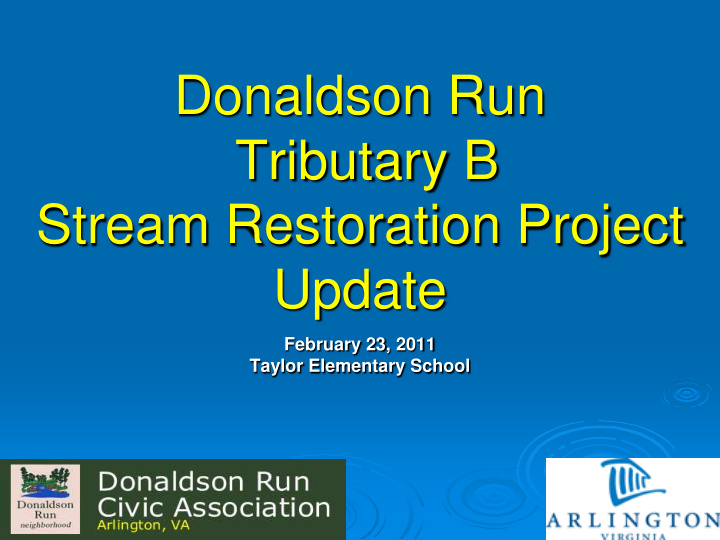



Donaldson Run Tributary B Stream Restoration Project Update February 23, 2011 Taylor Elementary School
‘Big picture’ concepts � Past land use and drainage decisions have severely impacted County streams � Watershed improvements and in-stream restoration efforts are both essential � Urban stream corridor damage must be addressed comprehensively � Stream restoration accomplishes multiple resource management objectives � Neighborhood partnership is essential
County/Donaldson Run Civic Association Partnership � 10+ year partnership � Stream restoration top neighborhood priority � NCAC approved Tributary B funding in December 2007; County Board 2008; DES providing additional funds � Extensive County/DRCA public process: meetings, workshops, stream walks, newsletter articles, park signs, Citizen articles, and other media coverage
Donaldson Run watershed Donaldson Run Watershed Boundary Tributary C Taylor School Tributary B Tributary A
KEY PROJECT FACTS: • Approved Neighborhood Conservation Program Project • 1,400 linear feet to Upton street • 26% impervious cover in watershed • Natural channel design approach
Review of changes from 30% to 60% design � Reducing width of channel/floodplain to reduce footprint and tree/valley impacts � Limiting re-location of pathway and narrowing pathway � Reducing disturbance and tree impacts below the footbridge
Updates from 60% design to current design level (~75%) � Step pool ‘grade control’ and ‘riffle’ structures � Analysis of hillside and storm pipe drainage inputs � Water main survey � Planting plan � Invasive plant management
Step Pool ‘Grade Control’ and ‘Riffle’ Structures � Control stream energy � Protect streambanks � Provide improved stream habitat
Hillside drainage inputs � Working with specific property owners � Accommodating flow inputs in project design
Storm pipe drainage inputs � Verifying easements/pipe conditions � Incorporating needed repairs/modifications into project design
30” Water Main – Primary Source of Supply to Lee Water Station � Long-exposed pipe segments in valley identified as 30” water main and surveyed to determine location � Interim work completed to protect exposed pipe � Few apparent conflicts with stream restoration design except at stilling basin � Small borings will be excavated to confirm pipe elevations � Stream restoration design will improve protection
Trees � No change in tree impacts from project from 60% designs to current design � One tree removed to protect water main (previously listed as a potential removal) � One tree has fallen (previously listed as a removal) � Project impact: 36 trees>10” diameter, 72 trees overall
Invasive Management & Planting Plan Goals: � To restore forest structure and function � To support recreational use and aesthetics
Invasive Management & Planting Plan Why invasive management? • Displace native species • Reduce wildlife habitat • Alter ecosystem processes “On a global basis...the two great Courtesy NPS destroyers of biodiversity are, first Japanese Barberry Japanese stiltgrass habitat destruction, and, second ( Berberis thunbergii ) ( Microstegium vimineum ) invasion by exotic species. — E. O. Wilson
Current Forest Conditions
Resources � Natural Resource Management Plan http://www.arlingtonva.us/departments/parksrecreation/docu ments/file76445.pdf � Ecological community mapping Modified urban landscape l � Species inventory for Zachary Taylor Park � “Keeping it Natural” http://www.arlingtonva.us/departments/EnvironmentalServic es/epo/PDFfiles/Keeping%20It%20Natural.pdf
Wisteria
Kudzu Invasive Plants � 85-95% invasive species in the shrub and ground layers � invasive species present on both park and private properties � 27 different species
Implications � Invasive management considerable component of the project � Project requires integrated planting and invasive plant removal � 4-6 year planting and invasive plant maintenance schedule � Complete removal of invasive species is likely not possible � Most successful if private citizens are involved in invasive management
Planting Plan � Site specific � All plants will be native to Zachary Taylor Park � Planting “zones” to account for habitat changes with elevation and distance from the stream. � Special plantings for sensitive areas � Multi-year to account for invasive control and natural forest succession
Zoned Planting - Example Slope Floodplain
Special Areas – Stream Banks
Special Areas – Bare Slopes
Scarlet oak Arrowwood Bluestem goldenrod Quercus coccinea Viburnum dentatum Solidago caesia
Invasive Management � Pre-project removal of invasive shrubs l outreach to homeowners l � During construction/planting “Clean” equipment l Mulch or mats for trees/shrubs l Seed heavily l Protect deer candy l Multiple planting cycles l
Invasive Management � Post-Project/Maintenance • Protect trees and shrubs • Focus on stream banks • Target species • Coordinate invasive removal and planting • Timing of control will depend on plant life cycle • Flexible and adaptive
English Ivy ( Hedera helix )
Next Steps � Continue work with property owners on hillside drainage inputs and design work for storm pipe drainage inputs � Finalize planting plan and invasive plant management plan � Develop construction access/staging plan � Hold stakeholder advisory group meeting prior to full design completion � Target design completion by end of summer � Construction schedule still TBD
Tributary A, June 2010 For more information contact: Jason Papacosma / Christin Jolicoeur Arlington County Dept. of Environmental Services Environmental Management Bureau (703) 228-3613 jpapacosma@arlingtonva.us cjolicoeur@arlingtonva.us Learn more at: www.arlingtonva.us – search “Donaldson Run.”
Recommend
More recommend